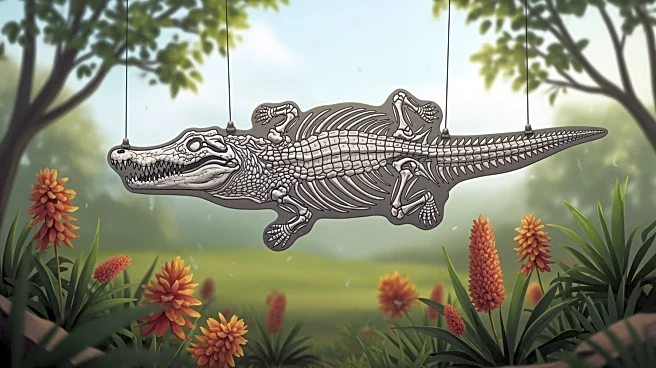What's Happening?
Researchers have identified a new species of carnivorous reptile, Tainrakuasuchus bellator, which lived 240 million years ago, predating the appearance of dinosaurs. This species, an early relative of modern crocodiles, was discovered in the Triassic
Favret Formation of Nevada, USA. The reptile, part of the Pseudosuchia group, was a dominant predator during the Triassic Period. Measuring approximately 2.4 meters in length and weighing around 60 kilograms, it possessed a long neck and agile body, allowing it to strike quickly at prey using slender jaws filled with sharp teeth. The discovery, detailed in the Journal of Systematic Palaeontology, provides insight into the complex ecosystems that existed before dinosaurs, highlighting the diversity and ecological niches occupied by different pseudosuchia species.
Why It's Important?
The discovery of Tainrakuasuchus bellator is significant as it enhances understanding of pre-dinosaur biodiversity and the evolutionary history of reptiles. It illustrates the complexity of ecosystems during the Triassic Period, a time when diverse reptilian communities had already formed. This finding also underscores the interconnected evolutionary history between South America and Africa during the era of the supercontinent Pangaea. The research offers valuable insights into the adaptation and survival strategies of ancient reptiles, contributing to the broader knowledge of how life evolved before the dominance of dinosaurs.
What's Next?
The discovery of Tainrakuasuchus bellator may lead to further paleontological investigations in regions that were part of ancient Pangaea, potentially uncovering more about the evolutionary links between continents. Researchers might focus on finding additional fossils to better understand the diversity and ecological roles of pseudosuchians. This could also prompt studies on the environmental conditions that facilitated the evolution of such diverse reptilian communities, offering a deeper understanding of prehistoric life and its adaptation to changing climates.
Beyond the Headlines
The naming of Tainrakuasuchus bellator reflects cultural significance, honoring the resilience of the people of Rio Grande do Sul, Brazil, in light of recent floods. This highlights the intersection of scientific discovery and cultural recognition, emphasizing the importance of local communities in preserving and understanding historical biodiversity. The discovery also raises questions about the preservation of rare fossils and the challenges in studying poorly understood lineages, which could lead to advancements in paleontological techniques and methodologies.















